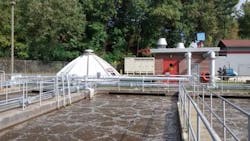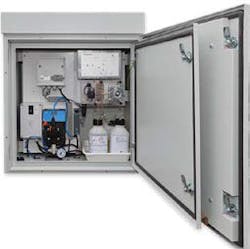Chemical treatment, biological treatment, and combinations of both are common methods for removing phosphorus in a wastewater treatment plant (WWTP). When using chemical treatment, metal salts that react with soluble reactive phosphate (i.e., orthophosphate) are added to form solid precipitates that are removed by physical processes such as clarification and filtration. The required chemical dosing rate depends on factors such as the targeted effluent phosphorous concentration, the influent phosphorus load and the amount of phosphorus that is being removed biologically.
The city of Black River Falls, Wisc., used chemical treatment with ferric chloride (FeCl3) to achieve its effluent total phosphorus (TP) permit of 1.0 mg/L. Historically, the chemical dosing rate was manually adjusted on a daily basis based on the measured effluent TP concentration. Besides the required manual labor, this method did not account for changes in influent loading, biological update or change in dosing requirement during weekends and holidays.
The plant was upgraded with an Oscar process performance optimizer control system with phosphorus controller, which uses continuous measurement of orthophosphate using a YSI IQ SensorNet P700 analyzer to automatically adjust the chemical dosing rate to maintain a desired effluent TP concentration without overdosing.
Plant Data
Phosphorus removal at Black River Falls WWTP was monitored with weekly measured influent TP concentration, and effluent TP concentrations were measured five days per week using laboratory wet-chemistry analysis. The chemical dosing rate was logged daily. Baseline data were gathered for one year prior to updating the plant. After upgrading with the Oscar system, the phosphorus removal and chemical consumption was measured for an additional year.
Phosphorus Control System
Using the Oscar system with phosphorus controller, the chemical dosing rate was continuously adjusted based on the real-time effluent orthophosphate concentration. The target effluent TP concentration was set to 1.0 mg/L.
Results
When the plant was upgraded to automatically adjust chemical dosing using a phosphorus analyzer, FeCl3 dosing rate decreased over 45% despite the influent TP load increasing by 20% during the first year of operation. The plant dosed an average of 22.9 gal of FeCl3 per day before the control system and analyzer installation. Additionally, this plant dosed an average of 11.5 gal per day of caustic to recover pH. After the upgrade, chemical consumption was reduced to an average of 12.5 gal per day of FeCl3 while still meeting the effluent phosphorus permit of 1 mg/L of TP. In addition, the optimized dosing eliminated the need to add caustic. The reduction in ferric and caustic dosing resulted in a payback period for installing the analyzer and control system of less than 20 months.
Conclusions
This study showed that the use of an online orthophosphate analyzer combined with automated controls can reduce chemical consumption and costs while maintaining effluent quality. In addition, upgrading with automatic control provides greater visibility of the process and improved operational stability. The reduced cost of chemical at Black River Falls WWTP gave a payback for the investment of less than 20 months.
“We realized significant FeCl3 and caustic cost savings during the first 12 months of the orthophosphate analyzer and controls installation. We also completely eliminated caustic usages due to controlled FeCl3 dosing. Currently, chemical dosing rate is controlled 24/7 based on the real-time effluent orthophosphate data and we do not need to worry about chemical feed pump operation.”
Editor's Note: Scranton Gillette Communications and the SGC Water Group are not liable for the accuracy, efficacy and validity of the claims made in this piece. The views expressed in this content do not reflect the position of the editorial teams of Water & Wastes Digest, Water Quality Products and Storm Water Solutions.

